Ankia Brahm and Andreas Tünnermann, Fraunhofer Institute for Applied Optics and Precision Engineering (IOF) and Institute of Applied Physics (IAP) of Friedrich Schiller University; Felix Wichmann, Carsten Gerth, Maryna Tymoshchuk, Stefan Riehemann and Gunter Notni, Frienhofer IOF
As radiation sources become more efficient, detectors become more sensitive, and acquisition speeds up, terahertz computed tomography holds promise for nondestructively finding and distinguishing between different materials by visualizing spatial information and distribution within a sample.
Working in the range of 1011 to 1013 Hz and 30 µm to 3 mm, terahertz radiation penetrates paper, clothing, plastics, ceramics and dry wood. It also is highly sensitive to water and to many organic substances that can be identified by their characteristic absorption spectra in this frequency range – for example, medications, illicit drugs and explosives. Semiconductors have a higher refractive index (typically n >3), but most are transparent for terahertz radiation, allowing new applications in the fields of security, quality control, production monitoring and identification in the food, chemical and pharmaceutical industries. The development of highly sensitive detectors, efficient radiation sources and fast acquisition techniques makes this frequency range increasingly attractive for spectroscopy, imaging and tomography.1,2
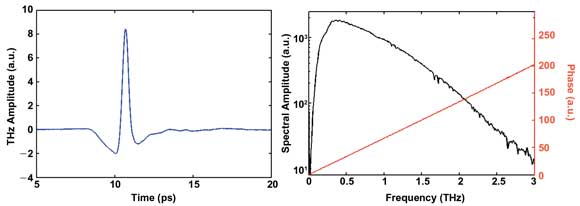
Figure 1. A time-resolved terahertz pulse is shown as an oscillation of the electromagnetic field (left); the spectrum of the pulse shows spectral and phase information (right).
In the past, several methods for generating and detecting terahertz radiation have been presented.3,4 At Fraunhofer Institute for Applied Optics and Precision Engineering IOF, we conduct research in the field of computed tomography with ultrashort terahertz pulses generated by a femtosecond laser source. Performing a coherent time-resolved measurement of terahertz pulses, we can detect amplitude and phase information and can calculate the spectrum of pulses with the Fourier transform (Figure 1). Amplitude information is used in 2-D imaging technologies to detect inhomogeneities or delamination errors in samples. With amplitude and phase information, it is possible to determine thicknesses and refractive indices of multilayer systems. Spectral information from terahertz pulses is used for spectroscopic measurements.5-7
A new tomographic imaging technique visualizes the spatial information and distribution of substances within a sample. X-ray computed tomography allows only the reconstruction of the absorption data, but terahertz computed tomography has high potential for new applications through measured amplitude as well as additional spectral and phase information; this data requires new algorithms and reconstruction strategies. Not only can we process complete spectral information from a tomographic measurement, but we can also identify different substances and localize them in a nondestructive way.8
To generate ultrashort terahertz pulses, we use an 800-nm Ti:sapphire femtosecond laser with a 100-fs pulse width, an 80-MHz repetition rate and 1-W average output power. The experimental setup is shown in Figure 2. The femtosecond laser beam is split into a pump beam leading to the terahertz emitter and three probe beams leading to different detectors in the transmission and reflection paths. An optical delay stage performs a time-resolved measurement. The terahertz emitter is an InAs semiconductor surface placed at an incident angle of 45°. Terahertz pulses pass through a silicon beamsplitter used for the reflection measurement at an angle of 0°.
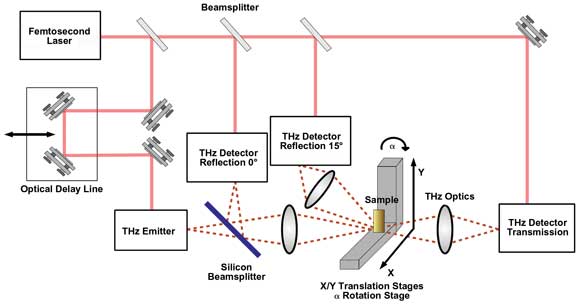
Figure 2. Setup of the terahertz system: According to the principle of computed tomography, a set of projections, measured through the sample at different angles, form an image, called a sinogram. One projection contains information from a line scan through the object under study performed at a specific angle. One measured terahertz pulse corresponds to one pixel in the line scan. To reconstruct the measured sample slice, the inverse Radon transform algorithm in combination with adapted filter techniques is typically applied to the sinograms.
The terahertz optics consist of off-axis parabolic mirrors that focus the radiation on the sample. Translational (X, Y) and rotational (α) stages move the sample according to the principle of computed tomography.9 One measured pulse is one pixel of the sample, which contains all parameters for reconstruction algorithms. The terahertz detectors are photoconductive antennas made of low-temperature-grown gallium arsenide. Femtosecond pulses are focused on the detector antenna to generate free charge carriers.
Illumination with a terahertz pulse leads to the acceleration of free charge carriers and results in a photocurrent that is proportional to the electric field of the incoming terahertz pulse. An optical delay line creates a temporal delay between a cycle of femtosecond and terahertz pulses. The pulse shape is acquired in the time domain by measuring the photocurrent while varying the time delay with the help of the delay line. Tomographic measurements are performed at room temperature. Background noise that is higher than the terahertz signals is canceled by averaging through the time sampling and by using a lock-in detection technique.
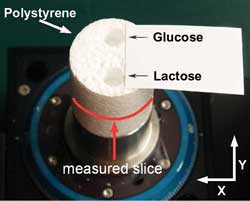
Figure 3. Prepared polystyrene sample fortomographic measurement of one layer.
Spectral information calculated from every pixel enables spatial identification of substances within the sample geometry. Each calculated spectrum is compared with database information, and a certain matching probability value is assigned for every pixel depending upon the substance. For every scanned sample slice, these probability values are arranged in sinograms to which the reconstruction algorithm is applied. Amplitude and phase information from the terahertz pulses can be arranged in sinograms to illustrate absorption or phase information.
To demonstrate the potential of terahertz computed tomography, we measured low-refractive foam samples filled with substances with characteristic absorption spectra. Figure 3 shows a polystyrene example with glucose and lactose powder. Figure 4 shows the extracted spectral information. The measurement of one slice with a lateral resolution of 1 mm consists of 180 line scans, corresponding to a rotation step of 2°.
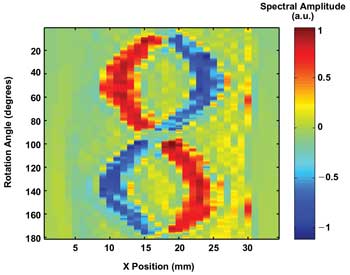
Figure 4. Sinogram of a measured slice.
The color coding defines the percentage comparison between the spectra of glucose and lactose. The value of 1 hereby corresponds with 100 percent matching probability to lactose, and —1 corresponds with 100 percent matching probability to glucose. Zero values refer to the polystyrene material, which has no characteristic absorption line of glucose or lactose; the yellow edge region is a result of artifacts implemented by the reconstruction algorithm.
Unwanted optical effects (e.g., refraction) at sample structures also lead to yellow-colored artifacts in the sinogram.
The results of sinogram reconstruction, seen in Figure 5, demonstrate clear localization and identification of lactose and glucose. Figure 5a shows the original reconstruction result, including artifacts, because of the reconstruction algorithm and unwanted optical effects in the sinogram. The artifacts can be filtered out with appropriate masks (Figure 5c), determined by extracting the time delay (phase) information from each terahertz pulse (Figure 5b). Figure 5d shows clearly allocated spectral information due to the reconstruction with the applied filter mask.
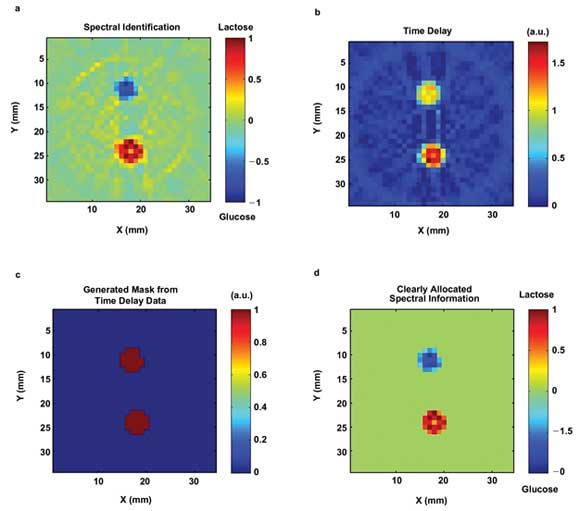 Figure 5. Reconstruction of one layer of the polystyrene sample: (a) original reconstruction, (b) phase information, (c) generated mask for filtering, (d) filtered spatial reconstruction.
Figure 5. Reconstruction of one layer of the polystyrene sample: (a) original reconstruction, (b) phase information, (c) generated mask for filtering, (d) filtered spatial reconstruction.
A new tomographic technology visualizes and identifies the spatial distribution of substances within objects: First, spectral terahertz computed tomography, nondestructive and noninvasive, realized the material classification. A femtosecond laser source and a coherent detection arrangement make it possible to detect much more information with terahertz computed tomography than with x-ray computed tomography. Because terahertz radiation wavelengths are long, lateral resolution is limited. This terahertz system reaches a lateral resolution of about 0.3 mm. Filtering techniques allow spectral uncertainties to be corrected and increase the accuracy of spectral computed tomography.
Faster data acquisition and improved correction filters will make this technology even more attractive for developing new nondestructive testing solutions, materials inspections and security tasks.
Meet the authors
Anika Brahm is an M.Eng. at Fraunhofer Institute for Applied Optics and Precision Engineering (IOF) in Jena, Germany, and a doctoral student at the Institute of Applied Physics (IAP), Friedrich Schiller University, also in Jena; e-mail: [email protected]. Felix Wichmann is a B.Eng. at Fraunhofer IOF. Carsten Gerth is a Dipl.-Ing. at Fraunhofer IOF; e-mail: [email protected]. Maryna Tymoshchuk is an M.Eng. at Fraunhofer IOF; e-mail: [email protected]. Stefan Riehemann is a PhD at Fraunhofer IOF; e-mail: [email protected]. Gunther Notni is a PhD at Fraunhofer IOF; e-mail: [email protected]. Andreas Tünnermann, the director of Fraunhofer IOF, is also the director of the IAP, where he is a full professor; e-mail: [email protected].
References
1. D.M. Mittleman, ed. (2003). Sensing with Terahertz Radiation. Berlin, Heidelberg: Springer Verlag.
2. M. Rochat et al (August 2002). Low-threshold terahertz quantum-cascade lasers. Appl Phys Lett, Vol. 81, pp. 1381-1383.
3. M. Tani et al (November 2002). Generation and detection of terahertz pulsed radiation with photoconductive antennas and its application to imaging. Meas Sci Technol, Vol. 13, p. 1739.
4. B. Pradarutti et al (Dec. 24, 2007). Multichannel balanced electro-optic detection for terahertz imaging. Opt Exp, Vol. 15, 17652-17660.
5. D.M. Mittleman et al (June 1999). Recent advances in terahertz imaging. Appl Phys B, Vol. 68, pp. 1085-1094.
6. B. Ferguson, X.C. Zhang (September 2002). Materials for terahertz science and technology. Nat Mater, Vol. 1, pp. 26-33.
7. A.G. Davies et al (2008). Terahertz spectroscopy of explosives and drugs. Mater Today, Vol. 11, pp. 18-26.
8. A. Brahm et al (July 2010). Volumetric spectral analysis of materials using terahertz-tomography techniques. Appl Phys B, Vol. 100, pp. 151-158.
9. J. Hsieh (2009). Computed Tomography Principles, Design, Artifacts, and Recent Advances. 2nd Ed. John Wiley & Sons Inc.